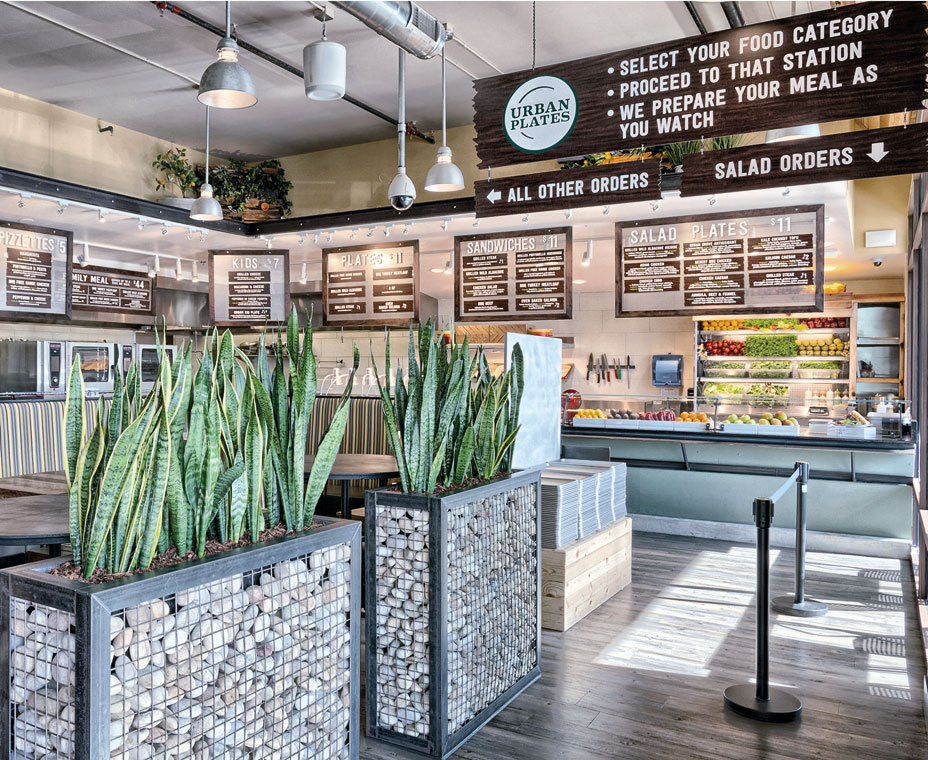Urban Plates didn’t necessarily start with a new idea, but rather with extensive research.
After about two years analyzing some of the new and established fast casuals—along with prepared-food formats seen increasingly in retail—the founders decided to merge it all together in one concept.
Since its first location opened six years ago in San Diego, Urban Plates has focused on freshly prepared displayed foods, giving guests variety and control over their experience. At the restaurant, food is split up by stations—whether it’s braises, salads, or plates—that are each manned by an employee who directly interacts with the guest ordering.
“You’re basically watching your own plate being prepared for you,” says cofounder Saad Nadhir. “That provides quite a bit of control and it provides a significant amount of transparency.”
Nadhir, who has spent his entire career in the restaurant and retail sectors and was a principal in the early development of Boston Market, is no stranger to the industry, and draws on his knowledge in making decisions for the brand. Important aspects of Boston Market, such as displayed food, have translated to Urban Plates, but the brand has a much more expanded menu that Nadhir says will reach more people. “We definitely are a restaurant, but we have a lot of the attributes that are valued by guests in a market. The visual aspect, for example; that’s very key. We appeal to all of the senses,” he says. “When you come in, there are beautiful displays of food and you’re shopping with your eyes and pointing.”
Urban Plates offers more than a dozen sides—both hot and cold—that guests can use to customize plates.
Entrées range from Turkey Meatloaf with house-made barbecue sauce to Chimichurri Grass-Fed Steak to the recently introduced Habanero Mango BBQ Ribs.
As the name would suggest, plates are at the heart of the concept. Nevertheless, it also serves a large selection of hand-tossed fresh salads, grilled sandwiches, pizzettes, and baked goods like scratch-made cookies, cream pies, and tarts.
Nadhir says the extensive menu helps eliminate the veto vote. “If you have a group of colleagues or a family coming, it’s hard to get everybody to agree on a single place to go and eat,” he says. “We wanted to be able to eliminate or minimize that veto and we wanted high frequency, so that’s driven by the different eating experiences, plus the way we prepare the meals.”
Urban Plates
FOUNDERS: Saad Nadhir and John Zagara
HEADQUARTERS: San Diego
YEAR STARTED: 2011
ANNUAL SALES: $4.5 million per unit
TOTAL UNITS: 12
FRANCHISE UNITS: 0
Each item on the menu serves a purpose and contributes to the quality of the dish, either in flavor or in healthfulness, Nadhir says. Every salad has about 12 ingredients, and the brand roasts its own nuts and makes its own dressings. Although Urban Plates allows for customization in plate combinations, it also serves an assortment of curated salads, sandwiches, soups, and braises to expedite throughput.
“We wanted to make sure that the degree of customization provided did not interfere with our ability to execute,” Nadhir says. “How quickly can you move the line? What’s the risk in having a guest pretty much mess up their meal by putting in the wrong ingredients? If we had build-your-own salads, honestly, it would be a mess; we couldn’t execute that given the amount of ingredients we have.”
Urban Plates capitalizes on both lunch and dinner dayparts with traffic split evenly between the two. The versatility of the menu makes it feasible for customers to visit the restaurant more than once in a single day. At lunch, a guest could order a curated salad like the Antioxidant—organic baby kale, cucumbers, celery, mint, pickled onions, raw walnuts, grapes, blue cheese, seasonal fruit, and a mint-lemongrass vinaigrette—and then return for a Moroccan Chicken Braise at dinner. The average check per person is about $15.
The brand has 12 units across California with plans to open one more unit in 2017 before ramping up growth. Nadhir says Urban Plates will eventually open 15 or more units per year, and he envisions having 70–80 restaurants in the next five years, with no plans to franchise.
Urban Plates isn’t planning to be in 50 states, and will concentrate on specific areas where ideal customers are located. Next year the company will begin opening its first locations outside of California, with plans to initially focus on the Washington, D.C., metro area.
“The paradox we tried to solve was really fine-dining quality with fine-dining hospitality at a reasonable price,” Nadhir says. “We spend a fair amount of money making sure it’s a high quality environment that is comfortable for eating in or appropriate for take-out.”
To further its commitment to the guest experience, Urban Plates also recently hired a former maître d’ from New York’s acclaimed Per Se as director of hospitality.
“He’s driving hospitality for us: how our people look, how our people behave, what their conversations are with our guests,” Nadhir says. “That’s going to be a pretty big pillar of the brand.”







